- Home
- →
- All excursions across Belarus from Minsk
- →
- Bobruysk - Krasnyiy Bereg
The cost of the tour Bobruysk - Krasnyiy Bereg for individual and corporate groups
| The cost of the tour | 2-7 | 8-19 | 20-52 | 53-68 | |
|---|---|---|---|---|---|
| The cost for the group | 53'357 | 65'473 | 83'951 | 94'757 | Book |
| Price for 1 person in the group | from 7'622 | from 3'446 | from 1'614 | from 1'394 |
Included in the price
- certified guide services
- transport services
Additional charge
- lunch
- entrance tickets
- 267 / 134
- 134 / 80
The excursion from Minsk to Bobruisk is more than just a trip — it’s a story with character and charm. Friendly, ironic, and truly colorful, Bobruisk welcomes guests with an atmosphere that many call the “Belarusian Odessa.” It was here that “all sons of Lieutenant Schmidt” longed to go — and you’ll understand why. A walk along the “Bobruisk Arbat,” encounters with local symbols, and of course, the famous Beaver — the city’s unofficial mascot of luck and cheer — will leave you with bright impressions and a warm smile.
Then the excursion leads to Krasny Bereg, where, in the quiet of a riverside park, you’ll discover the elegant Koziell-Poklewski Palace, like a scene from a fairytale. Here, history takes on form and style. And nearby — a striking contrast to the fairytale — stands the Krasny Bereg Memorial, silently speaking of sorrow and remembrance. This excursion from Minsk is perfect for those who seek not only beauty and knowledge, but also heartfelt experiences, emotional depth, and lasting memories.
The excursion program - Bobruysk - Krasnyiy Bereg
-
 Gathering the group
Gathering the group -
 Moving in Bobruisk (145 km)
Moving in Bobruisk (145 km) -

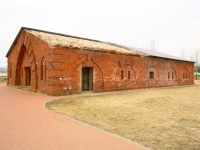 Bobruisk fortress
(visual inspection)Bobruisk fortress - fortification complex, which was built in the first half of the nineteenth century to defend the borders of the Russian Empire in the war with France. The fortress has an eventful history: it played a role not only in the war of 1812, but also in the Decembrist uprising - here was developed the famous «Bobruisk plan» of the uprising with the arrest of Alexander I during the inspection of troops, and after the uprising, some of his participants in the fortress were serving their term. Years of the Great Patriotic War - the darkest spot on the history of the fortress - at this time there was a concentration camp for Soviet prisoners of war.
Bobruisk fortress
(visual inspection)Bobruisk fortress - fortification complex, which was built in the first half of the nineteenth century to defend the borders of the Russian Empire in the war with France. The fortress has an eventful history: it played a role not only in the war of 1812, but also in the Decembrist uprising - here was developed the famous «Bobruisk plan» of the uprising with the arrest of Alexander I during the inspection of troops, and after the uprising, some of his participants in the fortress were serving their term. Years of the Great Patriotic War - the darkest spot on the history of the fortress - at this time there was a concentration camp for Soviet prisoners of war. -

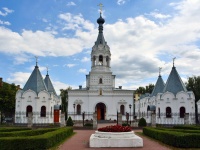 Georgievsk church in Bobrujsk
(visual inspection)One of the most interesting objects left on the territory of the fortress is St. George's Church. With a high degree of probability it can be argued that this temple was visited during the visit to Bobruisk in 1916 by Tsar Nicholas II. In 1928, the church follows the fate of most of the churches on the territory of the USSR: the domes are dumped, the bell tower is destroyed, and the garment production is located in the disfigured building. During the war in the temple there were German auto repair shops, and at its end - a canteen and a library. For almost 70 years the temple was in this terrible captivity, and in 1990 the temple building is returned to the believers.
Georgievsk church in Bobrujsk
(visual inspection)One of the most interesting objects left on the territory of the fortress is St. George's Church. With a high degree of probability it can be argued that this temple was visited during the visit to Bobruisk in 1916 by Tsar Nicholas II. In 1928, the church follows the fate of most of the churches on the territory of the USSR: the domes are dumped, the bell tower is destroyed, and the garment production is located in the disfigured building. During the war in the temple there were German auto repair shops, and at its end - a canteen and a library. For almost 70 years the temple was in this terrible captivity, and in 1990 the temple building is returned to the believers. -

 Monument to Soviet Soldiers in Bobruisk
(visual inspection)In memory of the events of the Great Patriotic War on the high right bank of the river. A monument was unveiled in Berezina. The command of the German fascist troops attached great importance to the retention of Bobruisk. The enemy created in the city and around it a deeply echeloned defense system. At dawn on June 24, 1944, the troops of the right wing of the 1st Belorussian Front launched an offensive to encircle and defeat the Bobruisk grouping of enemy forces. After a stubborn battle on June 29, 1944, the city was liberated. Moscow saluted the troops of the First Byelorussian Front, who captured Bobruisk. K.K.Rokossovsky commanded the troops of this front. It was for the successful preparation and conduct of the Bobruisk operation that he was given the rank of Marshal of the Soviet Union.
Monument to Soviet Soldiers in Bobruisk
(visual inspection)In memory of the events of the Great Patriotic War on the high right bank of the river. A monument was unveiled in Berezina. The command of the German fascist troops attached great importance to the retention of Bobruisk. The enemy created in the city and around it a deeply echeloned defense system. At dawn on June 24, 1944, the troops of the right wing of the 1st Belorussian Front launched an offensive to encircle and defeat the Bobruisk grouping of enemy forces. After a stubborn battle on June 29, 1944, the city was liberated. Moscow saluted the troops of the First Byelorussian Front, who captured Bobruisk. K.K.Rokossovsky commanded the troops of this front. It was for the successful preparation and conduct of the Bobruisk operation that he was given the rank of Marshal of the Soviet Union. -

 Monument to military units in Bobruisk
Monument to military units in Bobruisk
In a picturesque park in the center of Bobruisk there is a monument - a wall with a marble plaque and a red Soviet banner bent in front of it. It is a monument erected in honor of the military units and formations that distinguished themselves in the liberation of the city from the Nazi invaders during the Great Patriotic War. The stela was installed in 1965. This monument reminds us of the most brutal war in the history of mankind - the Second World War.
-

 Alley of the righteous people of the world in Bobruisk
The Alley of the Righteous Among the Nations is open on July 3, 2005; it was created in honor of the 15 natives of Bobruisk, during the Great Patriotic War, rescued Jewish families. The organizer of the installation of this monument was the city Jewish community. The title "Righteous Among the Nations" was established and appropriated by the Israeli Yad-Vashem Museum of Catastrophe (in the translation "Name and Memory ...) Israel continues to search and honor the righteous. Throughout the world, about 20,000 people are already counted among the righteous. Approximately 500 of them are from Belarus. According to the idea of the author of the project Galina Levina, the memorial sign is depicted in the form of a cut tree, the two halves of which are associated with inscriptions and symbolize the friendship between the Belarusian and Jewish peoples.
Alley of the righteous people of the world in Bobruisk
The Alley of the Righteous Among the Nations is open on July 3, 2005; it was created in honor of the 15 natives of Bobruisk, during the Great Patriotic War, rescued Jewish families. The organizer of the installation of this monument was the city Jewish community. The title "Righteous Among the Nations" was established and appropriated by the Israeli Yad-Vashem Museum of Catastrophe (in the translation "Name and Memory ...) Israel continues to search and honor the righteous. Throughout the world, about 20,000 people are already counted among the righteous. Approximately 500 of them are from Belarus. According to the idea of the author of the project Galina Levina, the memorial sign is depicted in the form of a cut tree, the two halves of which are associated with inscriptions and symbolize the friendship between the Belarusian and Jewish peoples. -

 Victory Square in Bobruisk
Bobruisk Victory Square is the central place in the city dedicated to the memory of the heroes of the Great Patriotic War. Opened in 1967, the square is adorned with a majestic obelisk, the Eternal Flame, and memorial plaques with the names of heroes. It serves as the venue for ceremonial events such as Victory Day and Independence Day celebrations. The square is harmoniously integrated into the urban landscape and attracts tourists who choose excursions around Belarus. Excursions from Minsk include a visit to the square, where guides share its history and significance.
Victory Square in Bobruisk
Bobruisk Victory Square is the central place in the city dedicated to the memory of the heroes of the Great Patriotic War. Opened in 1967, the square is adorned with a majestic obelisk, the Eternal Flame, and memorial plaques with the names of heroes. It serves as the venue for ceremonial events such as Victory Day and Independence Day celebrations. The square is harmoniously integrated into the urban landscape and attracts tourists who choose excursions around Belarus. Excursions from Minsk include a visit to the square, where guides share its history and significance. -

 Beaver monument
Beaver monument
Each city should have its own symbols, which are primarily associated with it from townspeople and tourists. Was not an exception and Bobruisk - it originated in a picturesque place - on the river Berezina. Once there was a small village, the inhabitants of which were engaged in fish and beaver industry. Therefore, according to some historians, the city received its name "Bobruisk". In 2006, the beaver became an unofficial symbol of the city and in one of the busiest places of the city a monument was erected - bronze, with a height of 1 m 70 cm, beaver, something subtly reminiscent of the venerable Bobruichanin of the beginning of the 20th century, cheerfully raises the hat-boat, passers-by.
-

 Скульптура Шуры Балаганава
Guests of restaurant, that has settled down in the reconstructed former water tower, Shura Balaganov cheerfully meets. The bronze sculpture of the hero of the novel of Ilf and Petrov "A gold calf" in 2 meters is a result of excellent work of the 26-year-old Moscow sculptor Yaroslav Borodin. Here it is possible to read a fragment from the novel where Babruysk is mentioned as the highly cultured city where all children of the lieutenant Schmidt aspired.
Скульптура Шуры Балаганава
Guests of restaurant, that has settled down in the reconstructed former water tower, Shura Balaganov cheerfully meets. The bronze sculpture of the hero of the novel of Ilf and Petrov "A gold calf" in 2 meters is a result of excellent work of the 26-year-old Moscow sculptor Yaroslav Borodin. Here it is possible to read a fragment from the novel where Babruysk is mentioned as the highly cultured city where all children of the lieutenant Schmidt aspired. -

 Synagogue in Babruysk
(visual inspection)The Bobruisk Synagogue is a significant historical and cultural monument and a spiritual center of the city's Jewish community. Built in the early 20th century, it stands out for its architectural style with elements of eclecticism and preserved fragments of paintings. The synagogue remains active, hosting religious services and cultural events. It is an important destination for excursions around Belarus, attracting tourists interested in Jewish history and culture. Excursions from Minsk offer an opportunity to learn more about the synagogue's role in the spiritual life of Bobruisk and its architectural features.
Synagogue in Babruysk
(visual inspection)The Bobruisk Synagogue is a significant historical and cultural monument and a spiritual center of the city's Jewish community. Built in the early 20th century, it stands out for its architectural style with elements of eclecticism and preserved fragments of paintings. The synagogue remains active, hosting religious services and cultural events. It is an important destination for excursions around Belarus, attracting tourists interested in Jewish history and culture. Excursions from Minsk offer an opportunity to learn more about the synagogue's role in the spiritual life of Bobruisk and its architectural features. -
 Moving in Krasnyj bereg (51 km)
Moving in Krasnyj bereg (51 km) -

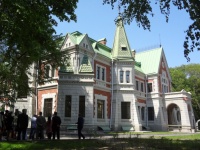 Manor Kozel-Poklevskih
The Kozel-Poklevski Manor is a historic gem of the Gomel region, where the architecture of the 18th-19th centuries meets picturesque nature. Surrounded by a beautiful park, the manor preserves the atmosphere of noble life, felt in every corner. It's the perfect place for lovers of history, architecture, and quiet walks in nature.
Manor Kozel-Poklevskih
The Kozel-Poklevski Manor is a historic gem of the Gomel region, where the architecture of the 18th-19th centuries meets picturesque nature. Surrounded by a beautiful park, the manor preserves the atmosphere of noble life, felt in every corner. It's the perfect place for lovers of history, architecture, and quiet walks in nature. -

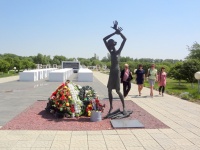 Memorial complex «Krasnyj bereg»
This place is symbolically named "Red shore". In the homonymous village is a memorial complex dedicated to children who died during the Great Patriotic War. Here, a "donor center" was created, where children were taken from all around the neighborhood, in order to deflate clean blood from young bodies. Blood was used for the wounded German army. A girl will meet you, who stands in the middle of an empty square and covers her face with her hands. And then an empty class of white dicks, however, no one will ever sit at these desks. Do not sit down those same 1990 students who died here. And only the letter of the little prisoner to the Pope, transferred to the school board, will tell you about the experiences here.
Memorial complex «Krasnyj bereg»
This place is symbolically named "Red shore". In the homonymous village is a memorial complex dedicated to children who died during the Great Patriotic War. Here, a "donor center" was created, where children were taken from all around the neighborhood, in order to deflate clean blood from young bodies. Blood was used for the wounded German army. A girl will meet you, who stands in the middle of an empty square and covers her face with her hands. And then an empty class of white dicks, however, no one will ever sit at these desks. Do not sit down those same 1990 students who died here. And only the letter of the little prisoner to the Pope, transferred to the school board, will tell you about the experiences here. -
 Lunch
Lunch -
 Moving in Minsk (200 km)
Moving in Minsk (200 km) -

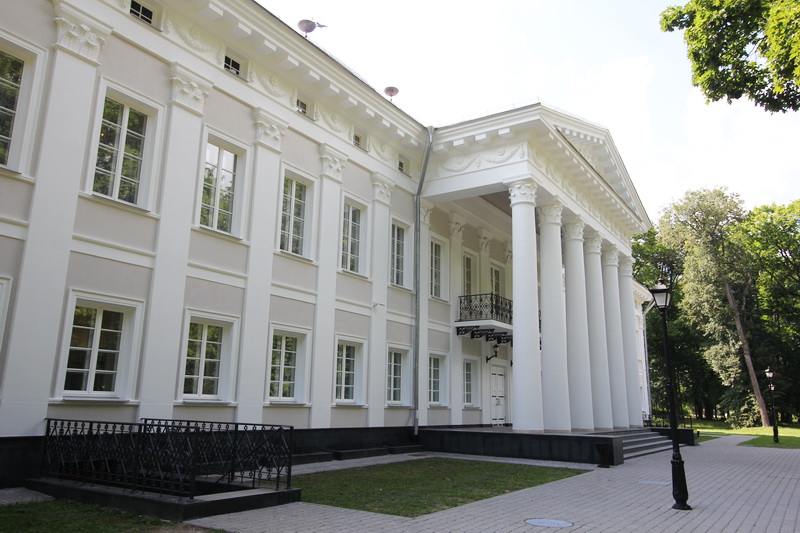 18:00 Palace of Bylgak in Zhilichi
The Zhilichi Palace is a unique architectural monument of the 19th–20th centuries in Belarus. The majestic building in the Classicist style is surrounded by a picturesque park covering 18 hectares. The palace was built by Ignacy Bulgak, who aimed to create the most beautiful residence in the region. Within its walls, there was a Catholic church, a tropical greenhouse, and halls with exceptional acoustics. The palace survived the wars intact. Here, visitors can see antique furniture, stucco molding, and gilded interiors.
18:00 Palace of Bylgak in Zhilichi
The Zhilichi Palace is a unique architectural monument of the 19th–20th centuries in Belarus. The majestic building in the Classicist style is surrounded by a picturesque park covering 18 hectares. The palace was built by Ignacy Bulgak, who aimed to create the most beautiful residence in the region. Within its walls, there was a Catholic church, a tropical greenhouse, and halls with exceptional acoustics. The palace survived the wars intact. Here, visitors can see antique furniture, stucco molding, and gilded interiors. -
➥The end of the tour
















